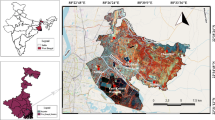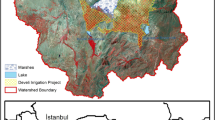Abstract
Land use and land cover (LULC) changes caused by human activities have strong influences on regional environment. Land surface temperate plays an important role in studying the impact of LULC changes on regional environment. In this paper, remotely sensed thermal infrared data were used to assess land surface temperature (LST) in the Weigan and Kuqa river oasis, Xingjiang, one of the important agricultural areas in the northwestern China. The present study deals with the extraction of LST and the relationship between LULC changes using Landsat 5 TM acquired on September 25, 1989, and September 6, 2011. The results indicate that the surface temperature of water body, bare land, and desert changed significantly between 1989 and 2011. In general, the LST was lower in 1989 than in 2011. There were no lower, higher, and highest temperature zones in 1989. However, the minimum temperature was 10.7 °C in 1989 and 15.8 °C in 2011. The maximum temperature was 29.3 °C in 1989 and 41.8 °C in 2011. Regarding the LULC types, the desert features in the Gobi Desert warmed more quickly than the oasis. So, the temperature of the oasis was lower than the surrounded areas, resulting in a so-called “cold island” phenomenon. Oasis cold island effect index (OCIEI) shows that stability of oasis had rising trend from 1989 to 2011. In addition, the impact of LULC changes on LST was analyzed and the driving forces were also analyzed from 1977 to 2011. This study is significant for further understanding of the energy exchange status of soil-plant-atmospheric system and the regional heat distribution in arid and semi-arid areas of the northwest China.
















Similar content being viewed by others
References
Abdisalam JLLD, Tohtugul T, Rabiye M (2013) Research on water and soil resources in Weiganhe River basin of Xinjiang. Hubei Agric Sci 52(11):2532–2535
Amiri R, Weng QH, Alimohammadi A, Alavipanah SK (2009) Spatial–temporal dynamics of land surface temperature in relation to fractional vegetation cover and land use/cover in the Tabriz urban area, Iran. Remote Sens Environ 113(12):2606–2617
Anderson MC, Norman JM, Kustas WP, Houborg R, Starks PJ, Agam N (2008) A thermal-based remote sensing technique for routine mapping of land-surface carbon, water and energy fluxes from field to regional scales. Remote Sens Environ 112:4227–4241
Biro K, Pradhan B, Buchroithner MF, Makeschin F (2013) An assessment of land use/land-cover change impacts on soil properties in the northern part of Gadarif region, Sudan. Land Degrad Dev 24(1):90–102
Carlson TN, Ripley DA (1997) On the relation between NDVI, fractional vegetation cover, and leaf area index. Remote Sens Environ 62:241–252
Chakraborty SD, Kant Y, Mitra D (2015) Assessment of land surface temperature and heat fluxes over Delhi using remote sensing data. J Environ Manag 148:143–152
Dash P, Gottsche FM, Olesen FS, Fischer H (2002) Land surface temperature and emissivity estimation from passive sensor data: theory and practice–current trends. Int J Remote Sens 23:2563–2594
Duan SB, Li ZL, Tang BH, Wu H, Tang RL (2014) Generation of a time-consistent land surface temperature product from MODIS data. Remote Sens Environ 140:339–349
Exelis Visual Information Solutions (2010) ENVI v.4.8.Boulder, Colorado: EXELIS.
Fang SF, Yan JW, Che ML, Zhu YQ, Liu ZH, Pei H, Zhang HF, Xu G, Lin XF (2013) Climate change and the ecological responses in Xinjiang, China: model simulations and data analyses. Quat Int 311:108–116
Guo Z, Wang SD, Cheng MM (2012) Assess the effect of different degrees of urbanization on land surface temperature using remote sensing images. Procedia Environmental Science 13:935–942
Hao HM, Ren ZY (2009) Land use/land cover change (LUCC) and eco-environment response to LUCC in farming-pastoral zone, China. Agric Sci China 8(1):91–97
Karnieli A, Agam N, Pinker RT, Anderson M, Imhoff ML, Gutman GG (2010) Use of NDVI and land surface temperature for drought assessment: merits and limitations. J Clim 23:618–633
Landsat Project Science Office (2002) Landsat 7 science data user’s handbook. Goddard Space Flight Center, Greenbelt, MD
Lazzarini M, Marpu PR, Ghedira H (2013) Temperature-land cover interactions: the inversion of urban heat island phenomenon in desert city areas. Remote Sens Environ 130:136–152
Li ZL, Tang BH, Wu H, Ren H, Yan G, Wan Z (2013) Satellite-derived land surface temperature: current status and perspectives. Remote Sens Environ 131:14–37
Li ZL, Tang R, Wan Z, Bi Y, Zhou C, Tang B (2009) A review of current methodologies for regional evapotranspiration estimation from remotely sensed data. Sensors 9:3801–3853
Liu Y, Hiyama T, Yamaguchi Y (2006) Scaling of land surface temperature using satellite data: a case examination on ASTER and MODIS products over a heterogeneous terrain area. Remote Sens Environ 105(2):115–128
Luo GP, Chen X, Zhou KF, Ye MQ (2002) Study on the spatio-temporal variability and stability of oasis in Sangong river watershed. Sci China (Ser D) 32(6):521–528
Maimatiyiming M, Ghulam A, Tiyip T, Pla F, Latorre-Carmona P, Sawut M, Halik Ü, Caetano M (2014) Effects of spatial pattern of green space on land surface temperature: implications for sustainable urban planning and climate change adaptation. ISPRS J Photogramm Remote Sens 89:59–66
Mallick J, Singh CK, Shashtri S, Rahman A, Mukherjee S (2012) Land surface emissivity retrieval based on moisture index from LANDSAT TM satellite data over heterogeneous surfaces of Delhi city. Int J Appl Earth Obstet 19:348–358
Men S, Chen DH (2005) Development and evolvement of Weigan river-Kuche river delta oasis and its sustainable development. Resour Sci 27(6):118–124
Mikaela SH (2013) Landscape change in Guatemala: driving forces of forest and coffee agro-forest expansion and contraction from 1990 to 2010. Appl Geogr 40:40–50
Mohan M, Kandya A (2015) Impact of urbanization and land-use/land-cover change on diurnal temperature range: a case study of tropical urban airshed of India using remote sensing data. Sci Total Environ 506:453–465
Nichol JE (2005) Remote sensing of urban heat islands by day and night. Photogramm Eng Remote Sens 71:613–623
Owen TW, Carlson TN, Gillies RR (1998) An assessment of satellite remotely-sensed land cover parameters in quantitatively describing the climatic effect of urbanization. Int J Remote Sens 19(9):1663–1681
Pei H, Qin ZH, Fang SF, Xu B, Zhang CL, Lu LP, Gao MF (2007) Impacts of land use/cover change on spatial variation of land surface temperature in Urumqi, China. In Geoinformatics 2007 (pp.67523P-67523P).International Society for Optics and Phntonics.
Pongracz R, Bartholy J, Dezso Z (2006) Remotely sensed thermal information applied to urban climate analysis. Adv Space Res 37:2191–2196
Pradhan B, Youssef AM (2010) Manifestation of remote sensing data and GIS on landslide hazard analysis using spatial-based statistical models. Arab J Geosci 3:319–326
Qin Z, Karnieli A, Berliner P (2001) A mono-algorithm for retrieving land surface temperature from Landsat TM data and its application to the Israel-Egypt border region. Int J Remote Sens 22(18):583–594
Rodriguez-Galiano V, Pardo-Iguzquiza E, Sanchez-Castillo M, Chica-Olmo M, Chica-Rivas M (2011) Downscaling Landsat 7 ETM+ thermal imagery using land surface temperature and NDVI images. Int J Appl Earth Obs 18:515–527
Rouse JW, Haas RH, Schell JA (1974) Monitoring the vernal advancement of retrogradation of natural vegetation. NASA/GSFC, type III, final report, Greenbelt
Sobrino JA, Jiménez-Muñoz JC, Paolini L (2004) Land surface temperature retrieval from LANDSAT TM5. Remote Sens Environ 90:434–440
Streutker DR (2003) Satellite-measured growth of the urban heat island of Houston,Texas. Remote Sens Environ 85(3):282–289
Srivastava PK, Majumdar TJ, Bhattacharya AK (2010) Study of land surface temperature and spectral emissivity using multi-sensor s atellite data. J Earth Syst Sci 119:67–74
Temesgen H, Nyssen J, Zenebe A, Haregeweyn N, Kindu M, Lemenih M, Haile M (2013) Ecological succession and land use changes in a lake retreat area (Main Ethiopian Rift Valley). J Arid Environ 91:53–60
Vijith H, Suma M, Rekha VB, Shiju C, Rejith PG (2012) An assessment of soil erosion probability and erosion rate in a tropical mountainous watershed using remote sensing and GIS. Arab J Geosci 5(4):797–805
Vlassova L, Perez-Cabello F, Nieto H, Martín P, Riaño D, de la Riva J (2014) Assessment of methods for land surface temperature retrieval from Landsat-5 TM images applicable to multiscale tree-grass ecosystem modeling. Remote Sens 6(5):4345–4368
Wakode HB, Baier K, Jha R, Azzam R (2013) Analysis of urban growth using Landsat TM/ETM data and GIS—a case study of Hyderabad. India Arab J Geosci:1–13
Weng Q (2001) A remote sensing-GIS evaluation of urban expansion and its impact on surface temperature in the Zhujiang Delta, China. Int J Remote Sens 22(10):1999–2014
Weng QH, Lu DS, Schubring J (2004) Estimation of land surface temperature-vegetation abundance relationship for urban heat island studies. Remote Sens Environ 89:467–483
Xiao HL, Weng QH (2007) The impact of land use and land cover changes on land surface temperature in a karst area of China. J Environ Manag 85(1):245–257
Youssef AM, Pradhan B, Tarabees E (2011) Integrated evaluation of urban development suitability based on remote sensing and GIS techniques: contribution from the analytic hierarchy process. Arab J Geosci 4(3–4):463–473
Zhang F, Tashpolat T, Ding JL, Gregory NT, He QS (2009) The effects of the chemical components of soil salinity on electrical conductivity in the region of the delta oasis of Weigan and Kuqa rivers, China. Agric Sci China 8(8):985–993
Zhang JQ, Wang YP, Li Y (2006) A C++ program for retrieving land surface temperature from the data of Landsat TM/ETM+ band6. Comput Geosci 32(10):1796–1805
Acknowledgments
We are grateful for the financial support provided by the National Natural Science Foundation of China (41361045, 41361016), the National International Scientific and Technological Cooperation Projects (2010DFA92720-12), the State Key Program of National Natural Science of China (41130531), the Young Technology-Innovation Training Program Foundation for Talents from the Xinjiang Uygur Autonomous Region (2013731002), the Key Laboratory of Oasis Ecology in Xinjiang University (XJDX0201-2012-01), and the PhD Graduates in the Scientific Research Foundation (BS110125). The authors wish to thank the referees for providing helpful suggestions in improving this manuscript.
Author information
Authors and Affiliations
Corresponding author
Rights and permissions
About this article
Cite this article
Zhang, F., Tiyip, T., Kung, H. et al. Dynamics of land surface temperature (LST) in response to land use and land cover (LULC) changes in the Weigan and Kuqa river oasis, Xinjiang, China. Arab J Geosci 9, 499 (2016). https://doi.org/10.1007/s12517-016-2521-8
Received:
Accepted:
Published:
DOI: https://doi.org/10.1007/s12517-016-2521-8




